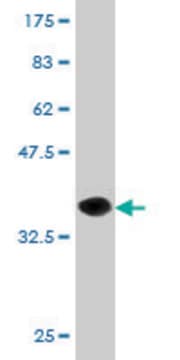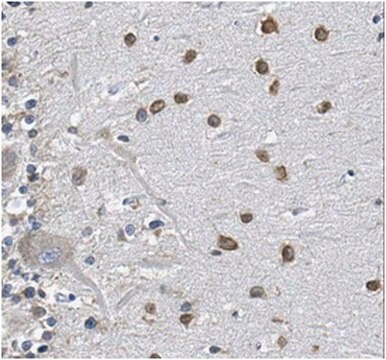MAB4051
Anti-Angiotensin Converting Enzyme Antibody, clone 9B9
clone 9B9, Chemicon®, from mouse
Synonym(e):
ACE, CD143, DCP1, Peptidyl-dipeptidase A, Peptidase P
About This Item
Empfohlene Produkte
Biologische Quelle
mouse
Qualitätsniveau
Antikörperform
purified immunoglobulin
Antikörper-Produkttyp
primary antibodies
Klon
9B9, monoclonal
Speziesreaktivität
hamster, feline, human, monkey, rat
Hersteller/Markenname
Chemicon®
Methode(n)
ELISA: suitable
immunocytochemistry: suitable
immunohistochemistry: suitable
immunoprecipitation (IP): suitable
western blot: suitable
Isotyp
IgG1
Eignung
not suitable for immunohistochemistry (Paraffin)
NCBI-Hinterlegungsnummer
UniProt-Hinterlegungsnummer
Versandbedingung
dry ice
Posttranslationale Modifikation Target
unmodified
Angaben zum Gen
human ... AGT(183)
Allgemeine Beschreibung
Spezifität
Immunogen
Anwendung
Neurowissenschaft
Hormone & Rezeptoren
Immunocytochemistry: 1:100. Reacts with endothelial cell, macrophages (activated) and THP1 cells (monocyte line).
Immunoblotting: 1:100: ~170-180kDa isoform, reducing conditions.
Immunoprecipitation: 1:1,000-1:10,000
ELISA : 1:1,000
Visualization of lung vessels (Danilov et al., 1989; Klibanov et al., 1988; Hiemisch et al., 1993)
Antibody mediated drug delivery into the lung (Danilov et al., 1991, 1994; Muzykantov et al., 1994, 1996)
Estimation of lung vessel injury (Muzykantov et al., 1991; Atochina et al., 1992)
Structure-function of ACE (Danilov et al., 1994)
Optimal working dilutions must be determined by the end user.
Physikalische Form
Lagerung und Haltbarkeit
Sonstige Hinweise
Rechtliche Hinweise
Haftungsausschluss
Not finding the right product?
Try our Produkt-Auswahlhilfe.
Lagerklassenschlüssel
12 - Non Combustible Liquids
WGK
WGK 2
Flammpunkt (°F)
Not applicable
Flammpunkt (°C)
Not applicable
Analysenzertifikate (COA)
Suchen Sie nach Analysenzertifikate (COA), indem Sie die Lot-/Chargennummer des Produkts eingeben. Lot- und Chargennummern sind auf dem Produktetikett hinter den Wörtern ‘Lot’ oder ‘Batch’ (Lot oder Charge) zu finden.
Besitzen Sie dieses Produkt bereits?
In der Dokumentenbibliothek finden Sie die Dokumentation zu den Produkten, die Sie kürzlich erworben haben.
Unser Team von Wissenschaftlern verfügt über Erfahrung in allen Forschungsbereichen einschließlich Life Science, Materialwissenschaften, chemischer Synthese, Chromatographie, Analytik und vielen mehr..
Setzen Sie sich mit dem technischen Dienst in Verbindung.







